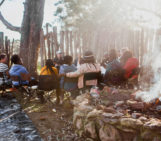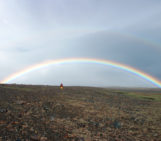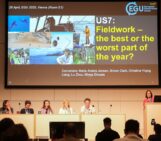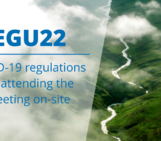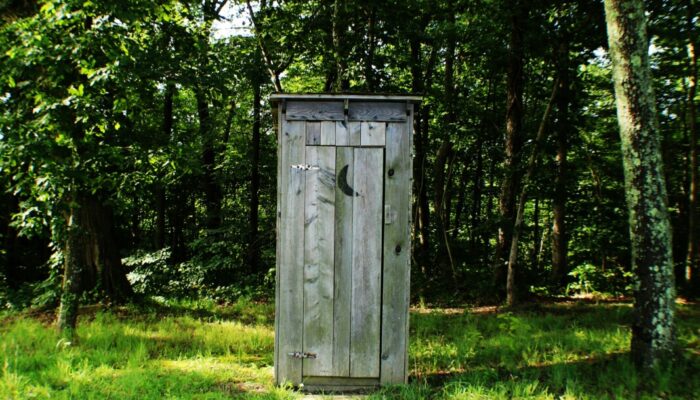
Field-based teaching is a cornerstone of geoscience education. Concepts such as scale, complexity, spatial awareness, 3D geometries, methods, skills, and techniques are inherently difficult to teach from a lecture theatre. However, achieving the benefits of field-based teaching might require a learning module not always considered as a prerequisite: planning and providing information about bathroom breaks.
One of my experiences at the Isle of Arran in 2001
The bus came to a halt in front of the giant, dilapidated hostel-like building, which at the time housed some 180 geology students from Edinburgh. The bus doors opened, and a horde of rapidly hobbling, knee-clenching female students poured out, engaging in scenes fit for Survivor or American Gladiators, doing their utmost to beat the competition to the few bathrooms on the first floor.
The year was 2001. I was one of those geology students taking a field course on the Isle of Arran. Our team of professors during those early years included just one woman. There was never any mention of toilets, periods, or breaks. We got on the bus in the morning and returned home in the evening. Hundreds of students, no bathroom breaks, and wide spans of sparsely vegetated moorland. It is safe to assume that the female students on that trip spent much of the day thinking about more pressing matters than the orientation of the Old Red Sandstone.
Health risks and the learning environment
As far as I know, none of the students on this trip fared ill—unlike what Gawain Antell experienced while teaching in Scotland in 2019. Perhaps we were spared by the typically wet West Coast Scottish weather of 2001, which helped save many kidneys from distress. Studies have shown that many women simply avoid drinking water to circumvent the need to urinate during field trips. The consequences can be dire, sometimes even causing long-term damage.
It’s not just kidneys that suffer from limited water intake. Such behaviour also sabotages the very purpose of field trips: learning. Research has shown that there is an inverse relationship between the degree of novelty—or psychological distraction—and the ability to learn. Concerns over physical aptitude, gear adequacy, or, yes, when the next toilet break might be, all contribute to this psychological novelty.
The cognitive costs of “distracted learning”
I have vivid memories of searching for places to relieve myself during field trips, evaluating options, rushing ahead or staying behind, and debating whether a certain ledge or cluster of trees would suffice as cover. I also remember the delicate balancing act of sipping small amounts of water, trying to perfectly calibrate necessary intake against limited output. It’s not hard to see how that mental effort could have been better spent.
Studies have shown that “distracted learning”—learning while also worrying about things like bathroom breaks—has several negative impacts:
- It is mentally exhausting and leave less cognitive capacity for learning.
- It impairs long-term retention.
- It leads to information being stored in less useful ways, rendering students less adept at applying and extending knowledge in new contexts (Schmidt, 2020).
On improving field courses
Field courses are a historic and ubiquitous part of geoscience education. As Himus and Sweeting wrote, “The reading of books and the study of specimens will never make the geologist; the geologist is made in the field, not in the laboratory.” Field-based teaching provides unique and essential learning opportunities that are hard to replicate in the classroom! However, field courses are not without challenges. They include environmental, physical, and psychological barriers such as steep terrain, group dynamics, bad weather, risks, and disengaged students.
Time to normalise bathroom breaks
While educators cannot control the weather—something I know all too well from navigating flood warnings in Norway—they can address other issues, such as minimising distracted learning (and UTIs). Don’t let something as simple as a toilet taboo detract from the purpose of the trip.
An informal survey revealed that toilet-break information is rarely provided to undergraduate students. Some responses even included dismissive comments like, “This is university, not kindergarten”. For people with female reproductive organs, urinating in the field is significantly more exposing and vulnerable than for their male counterparts. As an educator, you can free up mental space in students’ minds by being proactive and considerate:
- Talk About It: Normalise toilet discussions and inform students about bathroom facilities, breaks, or suitable locations before the trip.
- Plan for It: Schedule regular bathroom breaks. If facilities are unavailable all day, let students know in advance and provide time for discreet breaks.
- Consider It: Ensure access to gender-neutral bathroom facilities whenever possible.
It may seem trivial or feel awkward, but these small changes can make a significant difference. Give your students the freedom to focus on what really matters: learning. Help them hold the right stuff in and let the rest go.
References
De Paor, D. G., Whitmeyer, S. J., & Education, F. G. (2009). Innovation and obsolescence in geoscience field courses: Past experiences and proposals for the future. Geological Society of America Special Papers, 461, 45-56.
Dykas, M. J., & Valentino, D. W. (2016). Predicting Performance in an Advanced Undergraduate Geological Field Camp Experience. Journal of Geoscience Education, 64(4), 314–322. https://doi.org/10.5408/15-128.1
Elkins, J. T., & Elkins, N. M. L. (2007). Teaching Geology in the Field: Significant Geoscience Concept Gains in Entirely Field-based Introductory Geology Courses. Journal of Geoscience Education, 55(2), 126–132. https://doi.org/10.5408/1089-9995-55.2.126
Giles, S., Greene, S., Ashey, K., Dunne, E., Edgar, K., and Hanson, E.: Getting the basics right: a field-teaching primer on toilet stops in the field, EGU General Assembly 2020, Online, 4–8 May 2020, EGU2020-11723, https://doi.org/10.5194/egusphere-egu2020-11723, 2020.
Himus, G. W., & Sweeting, G. S. (1955). The elements of field geology.
King, H., & Andrews, J. (2011). Geological field skills course report and future plans Introduction. Planet, 24(1), 55–61. https://doi.org/10.11120/plan.2011.00240055
Kreier, F., 2024. Toilet Taboos Can Make Scientific Fieldwork Dangerous. Scientific American, Jan 2, 2024.
Maltese, A. V., Balliet, R. N., & Riggs, E. M. (2013). Through Their Eyes: Tracking the Gaze of Students in a Geology Field Course. Journal of Geoscience Education, 61(1), 81–88. https://doi.org/10.5408/11-263.1
Mogk, D. W., & Goodwin, C. (2012). Learning in the field: Synthesis of research on thinking and learning in the geosciences. Geological society of America special papers, 486(0), 131-163.
Petcovic, H. L., Stokes, A., & Caulkins, J. L. (2014). Geoscientists’ perceptions of the value of undergraduate field education. gsa Today, 24(7), 4-10.
Schmidt, S. J. (2020). Distracted learning: Big problem and golden opportunity. Journal of Food Science Education, 19(4), 278-291.

